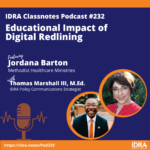

Educational Impact of Digital Redlining – Podcast Episode 232 | Classnotes Podcast 232
Podcast: Play in new window | Download
Classnotes Podcast (February 6, 2023). Public school investment has largely mirrored investment in parts of communities or certain neighborhoods. The discriminatory practice of redlining occurred when particular neighborhoods were marked as risky investments. Those neighborhoods had significant populations of people of color and families with low incomes. The redlining is illegal, most communities have not recovered or experienced new investment.
Digital redlining carries forward these inequities among marginalized groups through real access to affordable technology, digital content and broadband Internet. In this episode, Thomas Marshall III talks with Jordana Barton, vice president of community investments with Methodist Healthcare Ministries, about digital redlining and the fact that scarcity is a false assumption. The problem affects everyone and can be solved today.
Show length: 25:26 min
Send comments to podcast@idra.org
Sign up to receive free e-mail notices when new episodes are available.
Resources
IDRA’s Digital Equity – Online Technical Assistance Toolkit
In the Red – Drawing the Line on Digital Redlining Practices – Webinar
Digital Destination – Texas Needs Broadband Connectivity for All Students & Families, report by Thomas Marshall & Christina Quintanilla-Muñoz
The Parallel Roads to Digital and Racial Justice, article by Christina Quintanilla-Muñoz, M.Ed., IDRA Newsletter, October 2022
Your feedback
We welcome your comments and questions to the podcast. Use IDRA’s online form, or send an e-mail to podcast@idra.org.
Listen to every episode!
To ensure you don’t miss a single episode of IDRA Classnotes, subscribe to the podcast in iTunes, (download iTunes free if you don’t have it) or sign up to receive an e-mail alert as soon as a new show is published.



